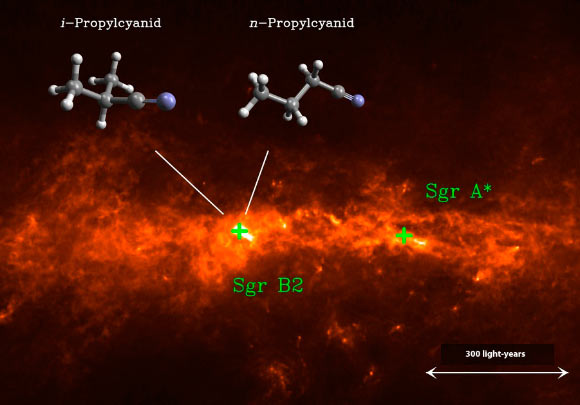Astronomers using the Atacama Large Millimeter/submillimeter Array have detected an unusual carbon-based molecule called iso-propyl cyanide (i-C3H7CN) in Sagittarius B2, a giant molecular cloud of gas and dust located 27,000 light-years from Earth and just 390 light-years from the center of our Milky Way Galaxy.

The iso-propyl cyanide molecule and its straight-chain isomer, normal-propyl cyanide, were both detected with the Atacama Large Millimeter/submillimeter Array in the star-forming region Sagittarius B2 (Sgr B2). Sgr A* is a complex radio source at the center of the Milky Way Galaxy. Image credit: MPIfR / A. Weiß / University of Cologne / M. Koerber / A. Belloche.
The search for molecules in space began in the 1960s, and around 180 different molecular species have been discovered so far.
Each type of molecule emits light at particular wavelengths, in its own characteristic pattern, or spectrum, acting like a fingerprint that allows it to be detected in space using radio telescopes.
Until now, the organic molecules discovered in star-forming regions have shared one major structural characteristic – they each consist of a ‘backbone’ of carbon atoms that are arranged in a single and more or less straight chain.
The iso-propyl cyanide molecule detected in Sagittarius B2 is unique in that its underlying carbon structure branches off in a separate strand. Such branched structure is a common feature in molecules that are needed for life – e.g. amino acids, which are the building blocks of proteins.
“Organic molecules usually found in these star-forming regions consist of a single ‘backbone’ of carbon atoms arranged in a straight chain. But the carbon structure of iso-propyl cyanide branches off, making it the first interstellar detection of such a molecule,” said Dr Robin Garrod of Cornell University, who is a co-author of the paper published in the journal Science.
But it is not just the structure of iso-propyl cyanide that surprised the astronomers – it is also plentiful, at almost half the abundance of its straight-chain sister molecule, normal-propyl cyanide (n-C3H7CN), which the scientists had already detected in Sagittarius B2 few years ago.
About 50 individual features for iso-propyl cyanide and 120 for normal-propyl cyanide were identified in the ALMA spectrum of the Sagittarius B2 region.
The two molecules – iso-propyl cyanide and normal-propyl cyanide – are also the largest molecules yet detected in any star-forming region.
“This detection opens a new frontier in the complexity of molecules that can be formed in interstellar space and that might ultimately find their way to the surfaces of planets,” Dr Garrod said.
_____
Arnaud Belloche et al. 2014. Detection of a branched alkyl molecule in the interstellar medium: iso-propyl cyanide. Science, vol.345, no. 6204, pp. 1584-1587; doi: 10.1126/science.1256678







